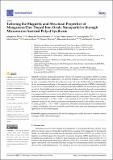Por favor, use este identificador para citar o enlazar a este item:
http://hdl.handle.net/10261/304174COMPARTIR / EXPORTAR:
 SHARE SHARE
 CORE
BASE CORE
BASE
|
|
| Visualizar otros formatos: MARC | Dublin Core | RDF | ORE | MODS | METS | DIDL | DATACITE | |

| Título: | Tailoring the magnetic and structural properties of manganese/zinc doped iron oxide nanoparticles through microwaves-assisted polyol synthesis |
Autor: | Porru, Margherita; Morales, M. P. CSIC ORCID ; Gallo-Cordova, Álvaro; Espinosa, Ana CSIC ORCID; Moros, María CSIC ORCID; Brero, Francesca; Mariani, Manuel; Lascialfari, Alessandro; Ovejero, Jesús G. | Palabras clave: | Magnetic nanoparticles MRI contrast agents Mn and Zn doping NMR Iron oxides Polyols technique Microwave synthesis |
Fecha de publicación: | 2022 | Editor: | Multidisciplinary Digital Publishing Institute | Citación: | Nanomaterials 12(19): 3304 (2022) | Resumen: | Tuning the fundamental properties of iron oxide magnetic nanoparticles (MNPs) according to the required biomedical application is an unsolved challenge, as the MNPs’ properties are affected by their composition, their size, the synthesis process, and so on. In this work, we studied the effect of zinc and manganese doping on the magnetic and structural properties of MNPs synthesized by the microwave-assisted polyol process, using diethylene glycol (DEG) and tetraethylene glycol (TEG) as polyols. The detailed morpho-structural and magnetic characterization showed a correspondence between the higher amounts of Mn and smaller crystal sizes of the MNPs. Such size reduction was compensated by an increase in the global magnetic moment so that it resulted in an increase of the saturation magnetization. Saturation magnetization MS values up to 91.5 emu/g and NMR transverse relaxivities r2 of 294 s−1mM−1 were obtained for Zn and Mn- doped ferrites having diameters around 10 nm, whereas Zn ferrites with diameters around 15 nm reached values of MS∼ 97.2 emu/g and of r2∼ 467 s−1mM−1, respectively. Both kinds of nanoparticles were synthesized by a simple, reproducible, and more sustainable method that makes them very interesting for diagnostic applications as MRI contrast agents. | Versión del editor: | https://doi.org/10.3390/nano12193304 | URI: | http://hdl.handle.net/10261/304174 | DOI: | 10.3390/nano12193304 | E-ISSN: | 2079-4991 |
| Aparece en las colecciones: | (INMA) Artículos (ICMM) Artículos |
Ficheros en este ítem:
| Fichero | Descripción | Tamaño | Formato | |
|---|---|---|---|---|
| taylorsyn.pdf | 6,13 MB | Adobe PDF |  Visualizar/Abrir |
CORE Recommender
PubMed Central
Citations
2
checked on 30-abr-2024
SCOPUSTM
Citations
5
checked on 23-abr-2024
WEB OF SCIENCETM
Citations
4
checked on 26-feb-2024
Page view(s)
39
checked on 30-abr-2024
Download(s)
73
checked on 30-abr-2024

